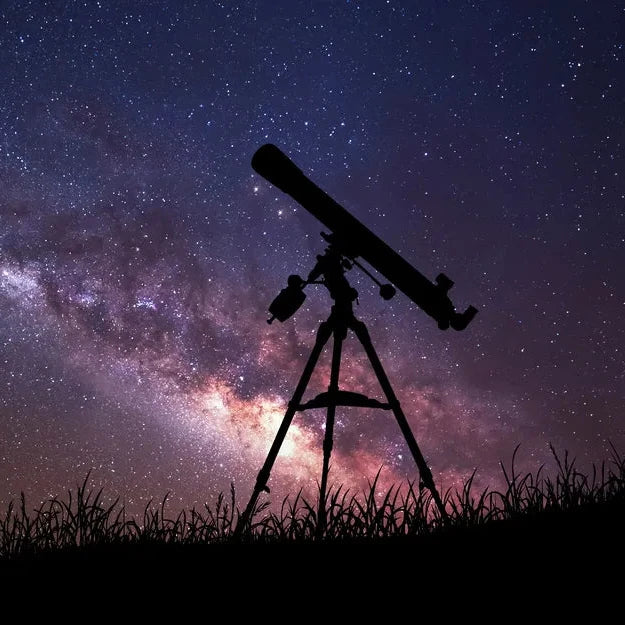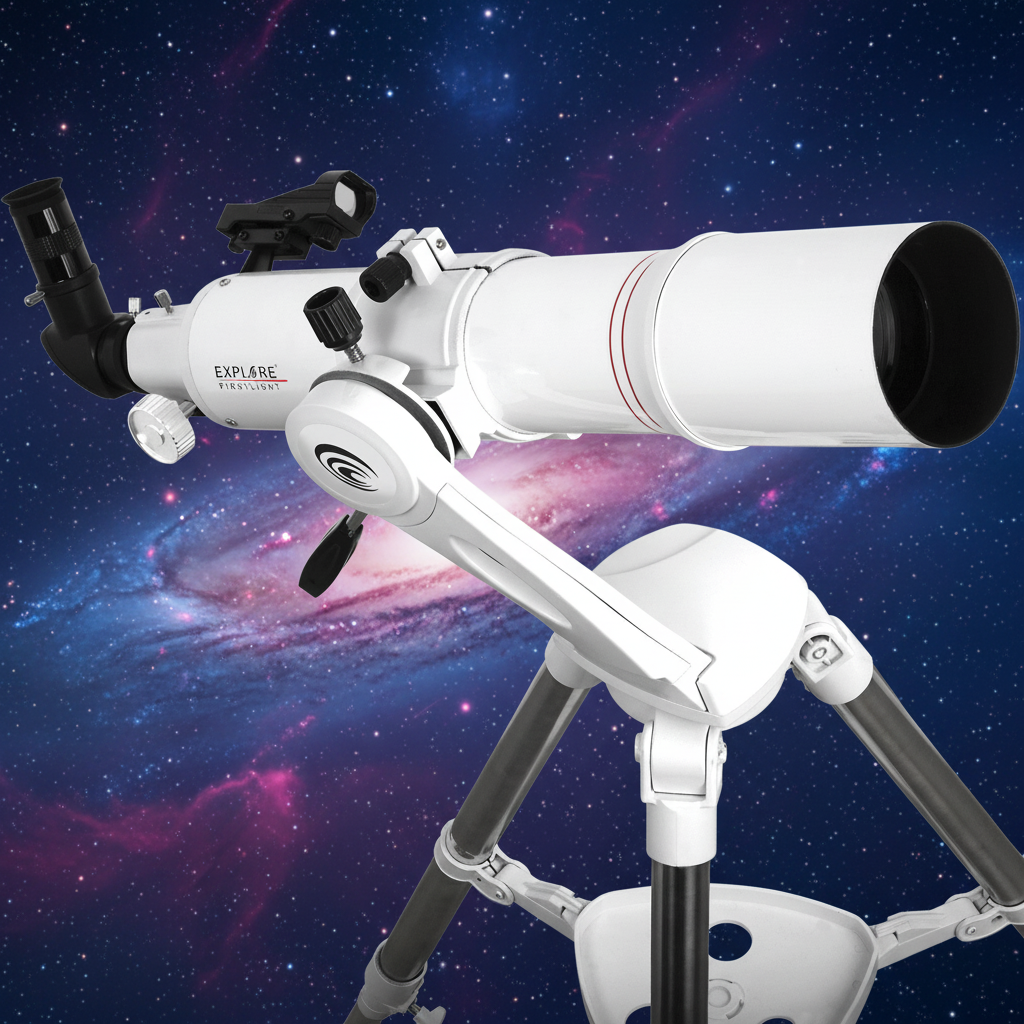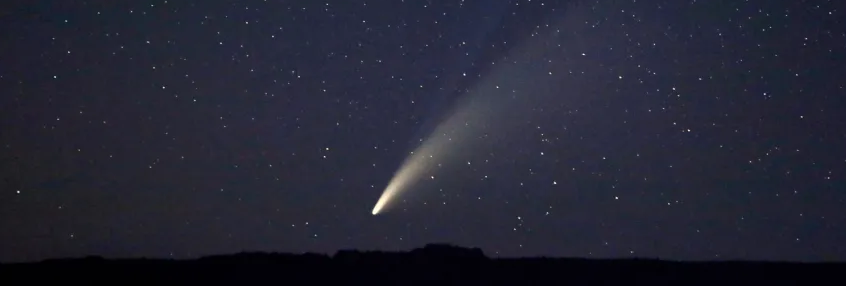对于许多业余天文学家来说,夜空中很少有景象能比发现彗星更令人激动。这些来自太阳系边缘的神秘访客常常出其不意地出现,它们闪亮的彗尾划破苍穹。但彗星究竟是什么?它们为何如此吸引我们的想象力?让我们来探索这些天体的本质,以及它们在太空中奇妙的旅程。
关于明亮彗星的每周信息

在开始彗星观测之前,请访问世界著名彗星观测者吉田诚一的网站,查看目前可见的明亮彗星。您会注意到,通常有几颗明亮的彗星可以用业余望远镜和双筒望远镜观测到。记下您想观测的每一颗彗星,然后返回此页面了解更多信息。
如何使用 Explore Scientific 的装备观察彗星。
选择您的设备
双筒望远镜:对于初学者或寻求广角视野的人来说,Explore Scientific 的Alpen Chisos 10x42 ED 双筒望远镜或Alpen Chisos 12x50 ED 双筒望远镜是不错的选择。这些型号的望远镜视野明亮宽阔,非常适合观测天空中昏暗模糊的彗星。
望远镜:
探索科学AR102 或 AR152 折射望远镜:这些消色差折射望远镜具有鲜明的对比度和清晰度,非常适合观察彗发的广角视图,甚至是彗尾的一些细节。
探索科学ED80或ED127 APO 望远镜:为了更近距离地观察彗星的核和尾,这些复消色差折射望远镜提供了出色的清晰度和色彩校正,非常适合视觉和天文摄影(我们提供天文摄影课程。)
探索科学 FirstLight 多布森望远镜(8 英寸或 10 英寸):这些多布森望远镜拥有更大的口径,能够在彗星接近地球时提供更明亮、更细致的视野。您将能够看到彗尾的更多结构,甚至可能看到彗核附近的一些活动。
Vixen R200SS反射望远镜
R200SS 配备超快 f4 200 毫米光学系统和抛物面主镜,可拍摄无色差、极其清晰的图像。其采用先进技术制作的特殊涂层,为彗星和深空天体的观测和拍摄提供了理想的表面。
设置并校准你的望远镜
极轴对准:如果您使用像 Explore Scientific iEXOS100 这样的赤道仪,请确保正确的极轴对准,以便顺利地追踪彗星穿过天空( 使用漂移法进行极轴对准)。
跳星:使用探索科学反射站将您的望远镜对准彗星预期位置附近的明亮恒星或行星,可以轻松微调您的跟踪并更轻松地跟踪彗星的运动。
寻找彗星
双筒望远镜:扫描彗星预计所在区域的天空。寻找一颗可能带有彗尾的暗淡、模糊的“星星”。
望远镜:首先使用低倍目镜(25毫米或30毫米),以获得更广阔的视野,更容易找到彗星。找到彗星后,切换到高倍目镜(10毫米或15毫米),以便更清晰地观察彗发和彗尾的细节。
观察主要特征
彗核和彗发:即使使用双筒望远镜或小型望远镜,您也会注意到明亮的彗核被发光的气体和尘埃彗发所包围。
彗尾:根据彗星的亮度, 你可能会观察到它的尘埃和离子尾。使用中高倍放大镜来研究彗尾的结构和细节。
可选:天文摄影
如果您热衷于天文摄影,可以使用 Explore Scientific 的 iEXOS100 等配备 PMC-Eight 系统的支架,通过数码单反相机或专用天文相机追踪彗星。长时间曝光可以展现彗尾和彗发的惊人细节。为了获得最佳效果,可以尝试使用 Explore Scientific ED80 等广角折射镜。
记录和共享
请务必与当地天文学团体或在线社区分享您的观测结果和图像。无论您是捕捉到第一眼的彗星,还是参与全球彗星追踪项目,您的贡献都有助于丰富探索宇宙的共享体验。
通过使用探索科学公司的世界级望远镜和双筒望远镜观察彗星,您将参与一场拉近宇宙的旅程,为新手和经验丰富的天文学家提供难忘的体验。
什么是彗星?为什么它们如此重要?

2015 年 3 月 17 日,罗塞塔号航天器的 OSIRIS 窄角相机拍摄的 67P 彗星的近似真彩色图像。图片来源:ESA / Rosetta / MPS 为 OSIRIS 团队(MPS / UPD / LAM / IAA / SSO / INTA / UPM / DASP / IDA)/ Justin Cowart
彗星是太阳系形成时期的古老遗迹,距今约46亿年。弗雷德·惠普尔博士将其称为“脏雪球”,主要由冰、尘埃和暗色有机物质构成。这些冰体为理解太阳系的形成和演化提供了宝贵的线索。一些科学家认为,彗星可能在向早期地球和太阳系内其他行星输送水和有机化合物(生命的基本组成部分)方面发挥了至关重要的作用。

彗星尘埃颗粒的电子显微镜图像。来源:NASA
彗星的核心是一颗来自太阳系遥远区域的冰体。当彗星靠近太阳时,太阳辐射会加热其表面,导致其冰在被称为“排气”的过程中蒸发。这一过程会释放出气体和尘埃,形成被称为“彗发”的炽热大气层。与此同时,太阳风将这些物质吹散,形成一条长达数百万公里的明亮“彗尾”。尽管彗尾体积巨大,但在阳光和太阳粒子的压力作用下,彗尾始终指向远离太阳的方向。
彗星的离子尾由CO+、N2+和CO2+等离子组成。当彗星进入太阳系内部时,太阳辐射会加热彗核,导致这些气体“沸腾”并电离。这些带电的离子与太阳风(太阳发射的带电粒子流)相互作用。这种相互作用会扭曲磁场线,形成始终指向背离太阳方向的磁尾。带电离子会沿着彗尾内的磁场线运动,这就是为什么离子尾始终指向太阳的反方向。
其中一种离子 CO+ 吸收阳光并发出荧光,发射波长为 4200 埃的蓝光。
彗星的组成:“脏雪球”
20世纪80年代初,当全世界都在期待哈雷彗星的回归时,年轻的斯科特·罗伯茨(Scott Roberts)在一家望远镜店工作,如饥似渴地学习天文学知识。正是在这段时间里,斯科特第一次接触到了弗雷德·惠普尔博士(Dr. Fred Whipple)开创性的“脏雪球”理论,该理论认为彗星是由冰、尘埃和岩石混合而成的。惠普尔博士认为彗星是太阳系形成时的残留物,在深邃的太空中保存了数十亿年。
斯科特对此十分好奇,决定迈出大胆的一步。他联系了当地的图书馆,希望能找到联系惠普尔博士的方法。令他惊讶的是,图书管理员提供了一个电话号码。斯科特犹豫了一下,但又充满好奇,于是拨了过去——更让他惊讶的是,接电话的竟然是弗雷德·惠普尔博士本人。
接下来是一场精彩的对话,惠普尔博士亲自解释了他的理论。他描述了彗星冰核(或彗核)在接近太阳时的行为,形成了炽热的彗发,以及地球上可见的离子尾和尘埃尾之间的区别。对斯科特来说,这段经历不仅仅是彗星科学的一堂课——它更是一次难忘的提醒:向我们敬佩的人伸出援手,可以打开我们从未想象过的大门。
彗星的大小和规模
彗星的大小差异很大,即使是最小的彗星也令人印象深刻。彗核的直径从几百米到几十公里不等。但彗发——围绕彗核的气体和尘埃云——可以膨胀到巨大的规模,有时甚至能达到地球直径的15倍。与此同时,彗尾可以延伸数百万公里,通常远远超出地球轨道。
虽然大多数彗星太暗,没有望远镜根本无法观测到,但也有少数彗星——被称为“大彗星”——亮度足以肉眼可见。这些罕见的现象对观星者来说堪称一场盛宴。
彗星从哪里来?
虽然彗星遍布太阳系各处,但它们主要集中在太阳系外层的两个主要区域:柯伊伯带和遥远的奥尔特云。位于海王星之外的柯伊伯带是短周期彗星的家园,这些彗星只需几十年就能绕太阳运行一周。奥尔特云是位于太阳系边缘的巨大冰体壳,它将长周期彗星送上轨道,其轨道周期可长达数千年甚至数百万年。
然而,有些彗星起源于星际,可能来自其他太阳系。首个被确认的星际天体是奥陌陌(1I/ʻOumuamua) ,于2017年被发现。虽然最初被认为是一颗彗星,但它缺乏彗发和彗尾的特征。其不寻常的轨迹和速度表明它起源于太阳系之外。
第二个确认的星际天体,也是第一颗确认的星际彗星,是2I/鲍里索夫,于2019年被发现。与“奥陌陌”不同,2I/鲍里索夫展现出彗星的典型特征,包括可见的彗发和彗尾。其双曲线轨道和高速度表明它来自星际空间,并且不会返回。
这些天体被认为是由于引力相互作用而被抛出其母恒星系统,并被送往星际空间进行探索。它们的发现开启了天文学的新篇章,为科学家提供了研究其他恒星系统物质的机会。
与行星或附近恒星的引力相互作用会改变彗星的路径,使其螺旋式地进入太阳系内部,以便我们能够观测到它。有些彗星只出现一次,然后就被抛回太空深处,而有些则会定期返回。
彗星是如何命名的?
彗星的命名和编号遵循国际天文学联合会 (IAU) 制定的具体准则。该命名系统为每颗彗星提供了一个独特的名称,并为其发现提供了重要的信息。以下是彗星命名和编号方法的详细说明:
临时指定
彗星首次被发现时,会根据发现年份、发现的半月以及该半月内发现的顺序,给予一个临时编号。该编号遵循特定的格式:
- 第一个字母:表示发现的半月(例如,“A”表示一月上半月,“B”表示下半月,等等)。
- 第二个字母:表示该半月内发现的顺序(例如,“C/2023 A1”表示2023年1月上半月发现的第一颗彗星)。
例如:
- C/2023 A1:2023 年 1 月上半月发现的第一颗彗星。
彗星类型前缀
在临时编号之前,字母前缀表示彗星的类型:
- C/:长周期彗星(轨道周期超过200年)。
- P/:轨道周期少于 200 年的周期性(短周期)彗星。
- D/:已经消失或解体的彗星。
- X/:尚未确定轨道的彗星。
- A/:最初被认为是彗星但后来被确认为小行星的物体。
例子:
- P/2023 A1:2023 年 1 月上半月发现的周期彗星。
以发现者的名字命名
一旦确认发现彗星,通常会以其发现者的名字命名。该名称可以纪念发现该彗星的天文学家或自动巡天程序。一颗彗星最多可以以三位发现者的名字命名。
例如:
- P/Shoemaker-Levy 9 彗星:以三位天文学家 Gene 和 Carolyn Shoemaker 以及 David H. Levy 的名字命名,他们共同发现了这颗彗星。
- 海尔-波普彗星:以独立发现该彗星的两位天文学家艾伦·海尔和托马斯·波普的名字命名。
- 2I/鲍里索夫彗星:以发现它的根纳季·鲍里索夫的名字命名,其中“2I”表示它是第二颗已知的星际彗星。
周期彗星的编号
一旦一颗周期彗星被多次观测到(通常至少两次),它就会被按照发现的顺序分配一个编号。这个编号放在彗星名称之前,表示它有一个已确认且可重复的轨道。
例子:
- 1P/哈雷:第一颗被发现的周期彗星,以埃德蒙·哈雷的名字命名。
- 67P/丘留莫夫-格拉西缅科:第 67 颗被发现的周期彗星,以其发现者克里姆·丘留莫夫和斯维特兰娜·格拉西缅科的名字命名。
完整名称示例:
- C/2023 A1(史密斯):一颗长周期彗星,于2023年1月上半月首次被发现,以发现者史密斯的名字命名。
- P/1996 R2(SOHO):SOHO(太阳和日光层探测器)航天器于 1996 年 9 月下半月发现的一颗周期彗星。
这种结构化的命名和指定系统确保了彗星识别和追踪的清晰度,使天文学家更容易对这些迷人的天体进行分类和研究。
如何搜寻和发现彗星

大卫·H·利维(David H. Levy)是当代最成功的彗星发现者之一,他曾无数个夜晚巡视星空,寻找彗星。他搜寻彗星的方法一丝不苟,井然有序,兼具耐心、敏锐的观察力以及对夜空的热爱。
利维的搜寻通常始于他信赖的望远镜之一,通常是一架小型望远镜,例如8英寸或16英寸的反射式望远镜。他会花费数小时系统地扫描天空,一次扫描一个区域。他的目标是识别那些在熟悉的星空背景下显得格格不入的天体。与彼此位置固定的恒星不同,彗星看起来像模糊或弥散的物体,会随着时间的推移略微运动。这种运动,加上它们特有的彗发或彗尾,使它们与点状恒星区分开来。
当利维扫视天空时,他敏锐地捕捉着任何偏离星空背景的物体。这个过程包括长时间观察同一片天空,使他能够探测到潜在彗星的细微运动。与清晰的星光相比,那些显得模糊或略微失焦的物体往往是第一条线索。如果一个物体在连续的观测中出现并似乎在移动,那么它可能是一颗彗星——一颗来自太阳系外层、正向内移动的冰冻流浪者。
利维的技能源于多年的实践,他学会了区分恒星、星系、星云和其他天体,并能识别出可能预示着新彗星的细微模糊。当他发现可疑物体时,他会反复检查该区域,确认其运动和外观,然后仔细记录和测量以追踪该物体。
这种“目视扫描”方法是一种老派的、实践性很强的方法,莱维几十年来一直精通。他的坚持和奉献精神,促成了20多颗彗星的发现,其中包括著名的舒梅克-莱维9号彗星,它于1994年与木星相撞。
莱维的彗星搜寻之旅证明了耐心、仔细观察的回报,以及在浩瀚的太空中发现新事物的喜悦。
如何报告彗星发现
报告彗星发现需要遵循特定程序,以确保该发现得到验证并获得官方认可。报告前,务必确认该天体确实是新发现。作为一名彗星探索新手,务必避免虚假报告,因为这可能会导致您背上观测不力的恶名。以下是如何正确报告彗星发现的方法:
确认对象是新的
在报告之前,您需要确保您发现的天体尚未被已知或编入目录。请对照现有数据库,例如小行星中心 (MPC) 和彗星目录。如果发现的天体似乎是新天体,请继续报告。
收集准确的观察结果
确保收集尽可能多的关于该物体的准确数据。基本信息包括:
- 发现的日期和时间(世界时,UT)。
- 物体的位置(赤经和赤纬,最好通过多次观测获得)。
- 物体的亮度(星等)。
- 物体在天空中的运动(速率和方向)。
- 物体的描述(外观、彗发大小、彗尾等)。
- 用于观察物体的望远镜和设备。
随着时间的推移进行多次观察以确认该物体是彗星,尤其要注意它是否具有弥散的外观、尾巴或彗发。
记录发现
保留所有观察的详细日志,包括确切时间、使用的设备以及任何可能影响观察的环境条件。
向小行星中心(MPC)报告这一发现
小行星中心 (MPC) 是新彗星发现的官方信息中心。您可以向 MPC 提交报告,MPC 将对您的发现进行评估。
如何提交
- 向 MPC 发送电子邮件至 cbat@cfa.harvard.edu,主题为“发现彗星”。
- 在您的报告中包括所有相关信息(位置、运动、亮度和任何其他观察结果)。
- 如果有多人参与了这一发现,请添加您的联系信息和任何合作者的姓名。
- MPC 的在线提交工具还允许业余天文学家提交彗星观测结果。
提供图像(如果可能)
如果您有该物体的图像或草图,请将其包含在报告中。高质量的图像有助于确认彗星的特征,例如彗发或彗尾。
待考
提交报告后,小行星中心和其他专业天文学家将尝试验证这一发现。他们将:
- 交叉引用现有对象以确保它之前未被编入目录。
- 收集其他天文学家的独立观察结果。
- 分析彗星的轨道以确认其性质。
获得官方认可
如果您的发现被确认为一颗新彗星,它将得到官方认可。该彗星将获得一个临时编号(例如,C/2024 A1)。如果该发现得到确认,您的名字(或您团队的名字)可能会被冠在彗星上(例如,史密斯彗星)。
继续观察彗星
验证你的发现后,请继续进行观测。这些后续观测有助于优化彗星的轨道,对于追踪其穿越太阳系的路径至关重要。
成功发现的秘诀:
- 定期观察:彗星的发现通常来自于定期的巡天和对地平线附近或远离黄道面的区域的系统观察,彗星经常出现在这些区域。
- 加入彗星发现小组:当今许多彗星都是由参与在线网络和合作的业余天文学家发现的,例如英国天文学协会或国际天文学联合会(IAU)的彗星分会。
- 使用自动化软件:许多业余天文学家使用自动扫描移动物体的成像软件。
要报告彗星发现,您需要确认该天体是新发现的,收集准确的观测数据,并将您的发现提交给小行星中心。经核实后,该彗星将被指定编号,并将发现者的名字与其关联。耐心和坚持至关重要,因为核实可能需要一些时间!
对有志于彗星猎人的最后思考
彗星数千年来一直吸引着人类的目光,至今仍令人们惊叹不已。无论你是经验丰富的观测者,还是初出茅庐的天文学家,发现一颗彗星都是一次令人回味无穷的经历,它将我们与宇宙的历史联系起来。
所以,下次你听到彗星划过夜空的消息时,不要犹豫——拿起你的望远镜或双筒望远镜去看看吧。你永远不知道什么时候会目睹这些冰冷的“访客”,它们将你与太阳系的远古历史联系起来。
请记住,正如斯科特·罗伯茨在与惠普尔博士的谈话中所了解到的,有时候,只需要一点好奇心和提出问题的勇气——理解的大门可能会以意想不到的方式打开。

















发表评论
所有评论在发布前都会经过审核。
此站点受 hCaptcha 保护,并且 hCaptcha 隐私政策和服务条款适用。